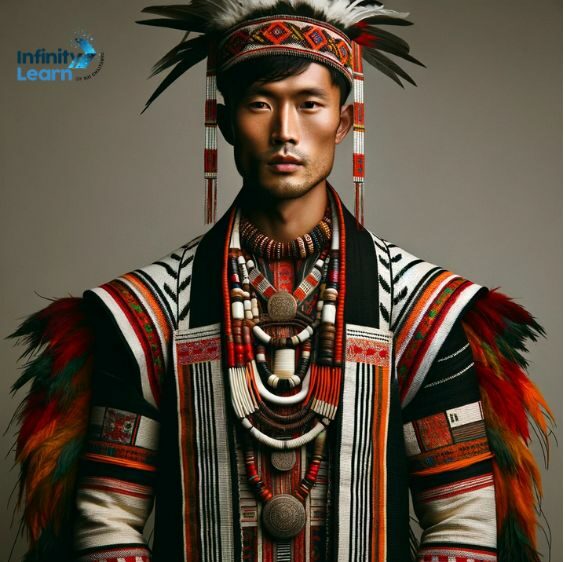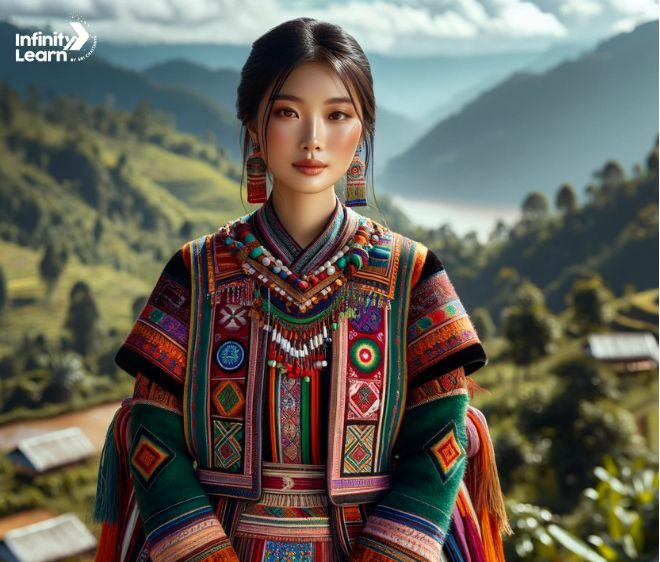Table of Contents
Nagaland, located in the northeast of India, is celebrated for its unique and diverse cultural legacy. This includes the distinctive traditional attire worn by its people, particularly noticeable in the Ao community, one of Nagaland’s prominent ethnic groups. The clothing of the Ao is not just an emblem of their identity but also symbolizes their collective pride and unity. These garments, known for their elaborate patterns and vivid hues, showcase the exceptional artistry and skills of Nagaland’s women. These artisans have diligently maintained and handed down these ancestral fashions over many generations, contributing to the rich tapestry of Nagaland’s cultural attire. Both men and women in Nagaland have their own specific traditional outfits, which are a vibrant expression of the region’s indigenous heritage. These costumes, deeply rooted in the tribal traditions of Nagaland, continue to play a vital role in preserving and celebrating the rich cultural narrative of the Naga tribes.
History of Nagaland Traditional Dress
Nagaland’s traditional clothing has a long and rich background, deeply connected to the lives and beliefs of the local tribes. Each tribe in Nagaland has its distinct style of dressing, using specific materials and crafting techniques. These outfits, like the Alungstu, Kilt, and Shawl, are not just clothes but represent the deep cultural roots and heritage of the Naga people. The dresses are known for their lively colors and intricate designs, which reflect the colorful culture of Nagaland. These garments, important to Naga culture, are being actively preserved and celebrated through various cultural events and fashion activities. The traditional wear of both men and women in Nagaland showcases the unique ethnic fashion of Northeast India, highlighting the artistic and symbolic traditions of the Naga tribes.
Nagaland Traditional Dress for Men
Shawls are a key element in the traditional clothing of men from various tribes. Each tribe has its own unique shawl pattern and color scheme, which represents their identity. These shawls are usually intricately woven and may feature designs that tell tribal stories or symbolize bravery and status.
Traditional headgear is also a significant part of the attire. These headpieces are often adorned with feathers, boar tusks, hornbill beaks, and bear fur, showcasing the wearer’s valor and accomplishments. The materials and designs used can vary greatly among different tribes.
Men also wear various types of jewelry, such as necklaces and bracelets made from beads, bones, and metals. These adornments serve not only as decorative items but also carry cultural significance.
Another important component is the waistcoat, typically bright in color and embellished with beads and cowries. Additionally, there’s the loincloth, known as a ‘lungi’ or ‘dhoti,’ often made from hand-woven fabric.
In some tribes, men’s traditional attire includes warrior outfits, complete with spears, daos (a type of machete), and shields. These items symbolize bravery and are frequently used during traditional dances and rituals.

Nagaland Traditional Dress Women
The traditional attire worn by women in Nagaland, a state in Northeast India, is a vibrant expression of the rich cultural heritage of the region. Each of the numerous tribes in Nagaland boasts its unique style, yet some common elements can be found:
- Naga Shawl: These shawls are a central piece of Naga women’s traditional clothing. They are renowned for their lively colors and intricate tribal designs, which can vary based on the wearer’s tribal identity.
- Mekhela: Similar to a sarong or a wraparound skirt, Naga women commonly wear the Mekhela. It is typically crafted from handwoven fabric adorned with tribal patterns and is usually paired with a matching blouse.
- Beadwork and Jewelry: Naga women embellish themselves with intricate bead necklaces, bracelets, and headgear. These accessories are not merely decorative; they often carry cultural significance, indicating marital status, social standing, and tribal affiliation.
- Traditional Blouses and Vests: Worn over the Mekhela, these garments are often embroidered with tribal motifs. The embroidery design and colors can vary significantly among the different tribes.
- Headgear: Some Naga tribes have distinctive headgear for women, constructed from bamboo, cane, and adorned with feathers, beads, and other ornaments.
- Aprons and Waistbands: In certain tribes, women wear aprons over the Mekhela, embellished with beads, shells, and metal ornaments. Waistbands, which are often intricately designed, are also a common accessory.

| Rajasthani Traditional Dress | Traditional Dress of Gujarat |
| Kerala Traditional Dress | Odisha Traditional Dress |
| Maharashtra Traditional Dress | Traditional Dress of Arunachal Pradesh |
| Goa Traditional Dress | |
Nagaland Traditional Dress Name
The traditional dress of Nagaland varies among the different tribes in the region. Here are some name of traditional dress of Nagaland:
- Naga Shawl
- Mekhela
- Angami
- Ao Dai
- Chakhesang Costume
- Konyak Attire
- Lotha Costume
- Phom Naga Dress
- Alungstu
- Khiamniungan Attire
- Neikhro
- Kilt
Nagaland Traditional Dress Male Name
The traditional attire worn by men in Nagaland is as diverse and steeped in history as the state’s rich cultural heritage. Here are some of the distinctive traditional outfits for men in Nagaland:
- Alungstu: This attire signifies prosperity and success and is usually worn by affluent men. It consists of a yellow-dyed fabric adorned with floral patterns.
- Khiamniungan Attire: The Khiamniungan tribe boasts a captivating traditional outfit for men, typically featuring a sleeveless black or blue cotton ensemble.
- Ratapfe: As part of their everyday attire, men in Nagaland often wear the Ratapfe, a black shawl embellished with embroidered cowrie shells in three or four rows.
- Rhikho: This dress is donned by men who have not yet hosted a grand feast or managed to capture prey. It comprises a white cloth with four bands of black color attached.
- Lungpensu: Characterized by a dark blue fabric adorned with five light blue stripes, narrow stripes at the edges, and a red and white checkered pattern in the center.
- Tsungkotepsu: An Ao warrior’s shawl featuring various figures like tigers, mithuns, elephants, cocks, human heads, and spears depicted on top of it.
Nagaland Traditional Dress Female Name
The traditional attire for women in Nagaland reflects the rich cultural heritage of the region’s diverse tribes. Here are some of the traditional dress styles for women in Nagaland:
- Azu Jangup Su: These are skirts adorned with red and yellow stripes, often worn on special occasions.
- Mechala: A piece of cloth wrapped around the skirt and draped like a shawl.
- Neikhro: This dress resembles a petticoat and is known for its unique colors and patterns.
- Moyer Tusk: An ordinary dark blue cloth with zigzag patterns at the end.
- Angami Tribe Dress: Women from the Angami tribe wear skirts made of blue and white cloth with thick black bands on the margins, which can vary in width.
| Culture of Rajasthan | Culture of Kerala |
| Culture of Manipur | Culture of Assam |
| Culture of Andaman and Nicobar Islands | Culture of Telangana |
| Culture of Bihar | Odisha Culture |
Traditional Dress of Nagaland Tribes
- Angami Tribe:
- Angami women wear blue and white skirts with thick black bands on the edges that come in different widths.
- Ao Tribe:
- Ao men don a sleeveless black or blue cotton outfit called “Alungstu,” symbolizing prosperity.
- Ao women wear “Neikhro,” a unique dress with a petticoat-like design, known for its distinct colors and patterns.
- Lotha Tribe:
- Lotha men wear black kilts adorned with embroidered cowries arranged in three or four lines.
- The Lotha tribe’s shawls are graded based on the number of festivals the wearer has attended.
- Sumi Tribe:
- The Sumi tribe’s traditional attire includes a shawl named “Tsungkotepsu,” featuring depictions of elephants, tigers, and human heads, signifying the owner’s affluence.
- Chang Tribe:
- The Chang tribe’s traditional attire consists of a black shawl called “Ratapfe,” designed for daily wear and durability.
- Konyak Tribe:
- The Konyak tribe boasts a unique traditional attire, an integral part of their rich cultural heritage.
- Khiamniungan Tribe:
- Khiamniungan men typically wear sleeveless black or blue cotton outfits, representing their cultural heritage.
- Phom Tribe:
- The Phom tribe’s traditional attire plays a significant role in preserving their unique traditions and heritage.
- Rengma Tribe:
- The Rengma tribe holds onto its traditional attire as an essential element of their cultural heritage.
- Sangtam Tribe:
- The Sangtam tribe showcases their distinct cultural identity through their traditional attire.
- Pochury Tribe:
- The Pochury tribe’s traditional clothing stands as a testament to their rich cultural heritage.
- Chakhesang Tribe:
- The Chakhesang tribe’s vibrant traditional attire reflects their cultural heritage.
- Yimchunger Tribe:
- The Yimchunger tribe’s traditional clothing highlights their unique cultural identity.
- Zeliang Tribe:
- The Zeliang tribe’s traditional attire is an integral part of their rich cultural heritage.
FAQs on Nagaland Traditional Dress
What is the traditional dress of Nagaland?
The traditional dress of Nagaland includes vibrant Naga shawls, wraparound skirts like Mekhela, and intricate beadwork, reflecting the rich culture of the Nagaland tribes.
What is the male costume of Nagaland?
Nagaland's male costume typically consists of a shawl, a loin cloth, and headgear adorned with feathers and beads, showcasing the unique heritage of the Naga tribes.
What is Nagaland dress material?
Nagaland dress material often involves handwoven fabrics made from cotton or wool, featuring tribal designs. These materials are used to make traditional Naga garments.
What is Nagaland shawl called?
The Nagaland shawl, known for its colorful patterns and significance in Naga culture, is often simply referred to as a Naga shawl.
What is Nagaland necklace called?
Nagaland necklaces, an integral part of Naga attire, are usually called Naga bead necklaces. They are made with beads and are often symbolic in Naga society.
What is the language of Nagaland?
Nagaland has several languages spoken by different tribes, but English is the official language. The state is home to numerous tribal languages, each unique to its tribe.









